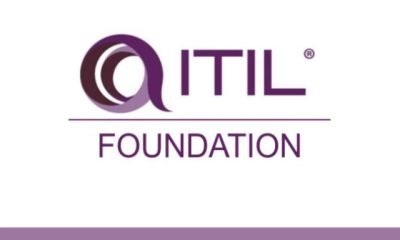Education
How to Come up with Creative Ideas for Your Research


Sometimes there are not enough ideas for scientific research. It seems like everything has already been studied. Actually it is not. Where to get research topics or how to come up with one – read the article.
Where to Get Ideas for Scientific Research
The topic often grows out of what excites and touches us to the core – not only at lectures and seminars, but also outside the academic environment: it can be a fact of your biography or a problem that worries.
You can use essay writing service to order the essay you need. To come up with a theme:
- think about what issues discussed in class are important to you;
- address disputes and conflicts between different researchers (classical and modern, in books and at conferences), try to understand different points of view and find your own approach;
- reflect on topics that hook you in the context of social issues and personal reflections.
Record your thoughts in the simplest possible way in a notepad or in a special application. The first idea can be very general and be expressed in one phrase – it is important to catch this blank for future work.
It is useful to have an electronic or paper notebook at hand during the entire course of work, depending on what you are used to. Our consciousness can throw a thought at any moment, and if it is not written down, it will be lost. At best, you will remember that you had some good idea; at worst, you won’t even remember that.
Do You Need to “Get Sick” with the Topic?
It’s good if the topic of an essay or dissertation arouses interest and emotions: love, passion, joyful excitement, or misunderstanding, irritation and anxiety. Such emotions are an invigorating driver that will not allow you to quit what you have started and will help you go through all the formal, routine and difficult stages of work: placing links, designing a bibliography, searching for sources, correct citation, etc.
There is another way to build relationships with text. The topic may not evoke any feelings – neither delight nor hatred. This means that you are rationally rather than emotionally building your path. Perhaps research on this topic will earn you a grant, or this paper needs to be written in order to complete a certain course. You have to live with your work for many hours, days, and sometimes months. If you are not indifferent to the topic, it will be easier for you to realize at every single moment why you are doing it. But there is a risk of entering into a “difficult (or even, as our interlocutors say, abusive) relationship with your own project both with a complete lack of interest and with excessive emotional involvement.
How to Choose a Topic according to Your Strength?
Think about it “lift”. A common mistake inexperienced researchers make is an optimistic view of time and opportunity. There will definitely be hitches, slowdowns, rewriting. Start from pessimistic forecasts. At best, you will have time, at worst, you will be mentally prepared.
You will need time to read and think about what you have read. If the research includes field work, it will take time to pilot and develop a draft (and, remember, to rewrite it). Allow time for all stages of research development, and not just for writing the final text.
Consult with the supervisor: ask if you have time to write a paper on the topic you are taking on. Teachers work a lot with texts, they will help to assess the amount of work, and, if necessary, narrow it down.
How to Make a Topic Unusual and Relevant?
This is necessary if you want to add an atypical field to your field, say something new, or go into interdisciplinarity. Try asking original questions. One of the scientists who started asking strange questions in sociology was Georg Simmel. For example: How does simple chatter happen and about what? How do people flirt? How do they have lunch? How do doors work in houses? Why does the picture have a frame? Such things simply could not come to the mind of serious researchers – but it turned out that this is possible.
Science fiction can serve as inspiration: it often describes what our world would look like if things went differently.
Relevance is the significance of a topic for your potential readership or for the general public, depending on the specialty. This is getting into the discussion that is being conducted around the issue of interest. You don’t write your paper in a vacuum: by writing you enter into a big conversation that takes place in your scientific field. The topic should be significant for someone – for 7 people, if you are dealing with an extremely exotic issue, for 50-300-500 people, if you write within the framework of some studies. Find conferences for researchers in your field or specialized journals. Look at the discussion going on there and think about what your topic might be of interest to your colleagues.
How to Combine Personal Interest and Relevance?
Yes, it sounds strange: on the one hand, you have to do what others do, because science is a team effort. On the other hand, you have to do something new, something new. On a field trampled down by thousands of researchers, you need to find a site where something valuable is hidden that others missed. Going and not repeating what others have already done is a creative task. To begin with, you can disagree with some of the researchers whose texts you read. You will need to find arguments to argue with these authors or offer something that they missed.
You do not know how your work will end? This is a big plus. You don’t have to pose a problem knowing how you’re going to end up solving it. The research task is precisely to discover the previously unobvious – for you, those around you and the discipline as a whole. Do not waste your time on everything that is understandable. You sit down to write a text to learn more and say something new, so cling to your questions.


Education
Revealing Your Musical Potential: How Structured Music Lessons Can Aid Novices


Discovering one’s musical capabilities begins with the first note, chord, or beat.
Music lessons for beginners is the journey into the realm of music, which can be both exhilarating and daunting. The secret to unveiling this potential resides in practice and structured lessons to build a strong foundation.
This article delves into how these lessons serve as a cornerstone for novices, enabling them to explore, understand, and refine their skills.
The Importance of a Solid Start
Embarking on this education requires more than just enthusiasm. A solid start, anchored in comprehensive music lessons for beginners, sets the tone for a learner’s journey. It ensures that fundamental concepts are not just introduced but understood and internalised.
This approach minimises confusion and builds a platform from which skills can be developed systematically.
Tailored Approach to Learning
Every individual possesses unique learning capabilities and musical inclinations. Structured lessons cater to these differences, offering tailored approaches that match the learner’s pace and interest.
This personalisation enhances engagement and ensures that each session contributes effectively to their progress. By addressing the learner directly, lessons become more than instruction; they become a dialogue between the student and the music.
Building Blocks of Musical Knowledge
At the core of music lessons for beginners lie fundamental concepts that are indispensable for all subsequent learning and mastery. These foundational elements encompass the comprehension of musical notation, the essence of rhythm, the scales’ structure, and the chords’ formation.
A firm grasp of these basics is pivotal for progressing to intricate compositions and diverse genres.
Furthermore, lessons meticulously crafted to systematically introduce and reinforce these concepts significantly contribute to cultivating a rich lexicon. They enable learners to interpret music more quickly and express themselves fluently through their chosen instrument.
This systematic approach ensures a well-rounded understanding, laying a solid groundwork for exploration and creativity in the journey.
The Role of Feedback and Correction
Structured lessons provide a platform for consistent and constructive feedback, allowing beginners to recognise their strengths and areas for improvement. This corrective mechanism is vital in avoiding the entrenchment of incorrect techniques, which can hinder progress.
The Joy of Early Achievements
Structured lessons aim to impart knowledge and recognise and celebrate every milestone achieved along the way, no matter how modest. Mastering a basic melody or composing a first piece are significant markers of progress, essential for boosting motivation.
These accomplishments are potent reminders to beginners of their strides, underscoring the tangible outcomes of their perseverance and hard work. Celebrating these successes is vital to maintaining enthusiasm and fostering a deep commitment to this art form. It instils confidence in learners, encouraging them to set and achieve new goals.
Beyond the Basics: Encouraging Exploration
Once beginners have a solid grasp of the fundamentals, these lessons evolve to encourage a journey beyond foundational skills. This new exploration phase invites learners to delve into various genres, fostering an appreciation for diversity.
Experimentation becomes key through composing original works, improvising within known pieces, or collaborating with fellow musicians.
These activities are instrumental in refining technical prowess while simultaneously amplifying creative expression. They offer novices a platform to unearth and cultivate their distinctive identity, enriching their learning experience.
By embracing this exploratory approach, learners broaden their musical horizons and gain deeper insights into their personal preferences and artistic inclinations.
Structured music lessons for beginners offer a comprehensive approach to unlocking the potential. By providing a solid foundation, personalised learning paths, and regular feedback, these lessons equip beginners with the tools necessary for their journey.
Beyond technique and theory, they foster a deep appreciation for this art form, encouraging continuous exploration and growth. In embracing this structured path, the journey of musical education is as rewarding as the destination.
Education
Tips and Hacks to Write a Mindblowing Persuasive Essay in College


The essay is not just about sharing facts; it’s about learning how to convince effectively. Imagine you can change minds and make a real impact with your words. That’s the essence of persuasive writing, a skill far beyond your college days.
If you want, you can think of it as a superpower when you can get people on board with your ideas. Ask for help from a professional essay writing service https://essayshark.com/ if you are a student who needs help with papers.
In our article, we’re here to help you become a pro at good writing. We’ve gathered practical tips and tricks to take your essays from good to mind-blowing.
Understand your readers
When writing essays, knowing your readers is like having a secret weapon. Imagine you’re a magician who knows precisely what tricks will amaze people who read you.
The best case is if you think of your audience as a puzzle. You must understand how each piece fits together to create a complete picture. Knowing what your readers care about, their opinions, and their values helps you craft arguments that hit home.
Choose the right statement
When crafting top-notch essays, imagine your thesis statement as the heart of your essay. It’s like a sentence that tells your readers what your essay is about and what you’re trying to prove. Think of it as a title that grabs attention and sets the stage. Think of your statements as signs on a map that guide the reader from one point to another. Once you understand it, it should be like a clear path, showing your readers where your essay is going. Avoid using complicated words. Also, make sure you can back it up with evidence.
Do in-depth research
In this section, you should consider your arguments a house built on a solid foundation. Well-researched evidence gives your arguments weight and credibility. It shows that your ideas aren’t just opinions but are grounded in facts, data, and expert opinions. Look for sources from reputable institutions, experts in the field, and peer-reviewed publications. Online databases, academic journals, and library resources are your treasure maps. It’s a good idea to think of your essay as a mosaic of different information, facts, and opinions.
Structure an essay effectively
Creating an essay is like building a house; you need a solid structure. For example, imagine your essay as a story. The introduction is the exciting beginning, the body paragraphs are the meaty middle, and the conclusion is the satisfying ending. Hook your readers with a thought-provoking question, an interesting fact, or a compelling fun moment. In the conclusion, wrap up your essay by summarizing your main points and leaving a lasting impression. Remember, a well-structured essay is like a well-built house – it’s sturdy, easy to navigate, and leaves a lasting impression.
Use persuasive language
Imagine your words as arrows that hit the bullseye. Persuasive language can evoke emotions, provoke thoughts, and drive action. It helps you connect with your readers on a deeper level, making your arguments more compelling. Also, you can think of your essay as a painting. Your words are the brushstrokes that create vibrant images. Use words like “crucial,” “undeniable,” “transform,” and phrases like “imagine if” to add impact. Metaphors, similes, and vivid descriptions also make your writing vivid. Remember to balance emotional appeal, logic, and credible evidence for the most convincing effect.
Think about visuals
What about imagining your essay as a dynamic presentation? Visuals like graphs, charts, and images can be your slides. They add a new dimension to your arguments, making them more memorable and easy to understand. Visuals make complex information digestible and compelling, reinforcing your arguments visually engagingly. Use them strategically to enhance, not overpower, your content. Place visuals where they naturally fit and provide context.
Edit and proofread
In this part, you can imagine your essay as a sculpture. Editing and proofreading act like polishing, turning your essay from raw material into a polished work of art. During this phase, you can spot mistakes, improve clarity, and strengthen your arguments. Think of editing as tidying up a room. Check for grammar and punctuation errors – those little distractions that can take away from your message. Ensure your sentences are clear, concise, and easy to follow. Cut out unnecessary jargon and replace vague words with precise ones.
Afterall
Remember, mastering the art of persuasive essay writing takes time and effort. Like any skill, it requires practice, dedication, and a willingness to learn from each experience. Each essay you craft is an opportunity to refine your persuasive prowess further. Best of luck on your writing journey!
Education
7 Tips for Writing Short Stories That Captivate and Resonate


If you are a writer not passionate enough to write a long novel or book series, short stories are an answer to your problem. Short stories hold a remarkable ability to captivate readers in a brief span of time, leaving a lasting impact that stays with them even after they have finished reading them.
However, crafting a perfect short story is not easy enough. You will need to have a delicate balance of creativity, skill, and an understanding of the elements that can make a narrative shine. That’s what we are going to teach you in this blog.
Below in this article, we have outlined useful tips for writing short stories that will engage your audience on a deep and emotional level. Read on to find out.
1. Start with a Strong Hook
There is nothing better than a powerful opening that immediately grabs the reader’s attention and compels them to keep reading your story. The first few sentences of your story are crucial in setting the tone, piquing curiosity, and establishing a connection with the reader.
To make your story opening strong enough, you will have to start it with something like a compelling question, an intriguing scenario from your story, a vivid description, or a thought-provoking statement. Just make sure anything you use should create a sense of intrigue and engage readers on a deeper level.
You can also consider incorporating elements of surprise, tension, or mystery to capture their imagination from the very beginning. This strong opening will then set the stage for the narrative, generating anticipation and signaling that something extraordinary is about to come their way.
2. Develop Engaging Characters
Your memoir can’t be completed without characters, so make sure you make their journey and experiences engaging enough for readers to be emotionally invested in the story. To create engaging characters, you will have to go deep into their personalities, motivations, and conflicts.
Give them distinct traits, desires, and flaws that make them relatable and three-dimensional. Also, consider their backgrounds, relationships, and the events in their life that have shaped them. By crafting well-rounded characters, you will be able to invite readers to connect with their struggles and triumphs.
Furthermore, ensure to make your characters undergo visible transformation and growth throughout the story. To do this, you will have to put challenges in their life, make them choose between two extremes, and put them in difficult situations. Doing all this will make your story captivating within the minimum number of words.
3. Choose the Right Type of Publishing
If you want to maximize the impact of your work, you will have to know all about publishing a short story. Different publishing options offer unique benefits and considerations to consider.
Traditional publishing involves submitting your short stories to literary magazines or journals, where you will have to wait for them to provide you with editorial support.
On the other hand, the self-publishing option is also there to empower you to take control of the entire publishing process. It offers creative freedom, quicker publication timelines, and higher royalty fees. You can self-publish your short stories digitally through platforms like Amazon Kindle or in print-on-demand formats.
You can also share your work through personal blogs, social media, or online writing communities, allowing instant feedback, collaboration, and the chance to build an online following.
4. Keep Them Concise
In the realm of short fiction, conciseness is key, as it allows for focused storytelling. Every word within the short story counts, so each sentence should serve a purpose in advancing the narrative or developing the characters.
This approach will ensure that the pacing remains tight and the reader’s attention is held from beginning to end. So, make sure to trim away any unnecessary details or digressions that may distract readers from the core of the story.
Just put your focus on conveying emotions, creating vivid imagery, and exploring the themes with precision. It will eventually force you to make deliberate choices, conveying depth and complexity within the limitations of a shorter format.
5. Maintain a Clear Narrative
Clarity in storytelling ensures that your ideas are effectively communicated, and the reader can follow the progression of events. You can establish a clear narrative by starting with a clear beginning, introducing the main characters, setting, and central conflict.
Also, make sure to develop the story with purpose, maintaining a logical sequence of events that build tension and intrigue. Just stay away from writing any confusing plot twists that may detract from the overall coherence.
After this, as the story unfolds, keep the reader engaged by providing clear transitions and maintaining a consistent tone. Each scene and event should contribute to the overall narrative arc, leading towards a satisfying resolution or revelation at the end.
6. Edit and Revise Again and Again
No great story is born in its final form. It is through the process of refining and polishing that a story truly comes to life. So, once you have completed writing your initial draft, set it aside for a while to gain a fresh perspective of the story.
Then, return to your story with a critical eye and start editing for clarity, coherence, and consistency. Trim unnecessary details, tighten sentences, and refine dialogue to enhance the overall flow and impact.
After you are done editing, ensure to revise your work by going deep into the layers of your story. During this process, analyze character motivations and strengthen plot points. Look for areas where you can heighten tension, create more impactful scenes, and deepen the themes explored.
7. Make Every Word Count
As mentioned above, the power of a short story lies in the careful selection and placement of each and every word. To ensure this, you will need to have a keen eye for the precision of language. Aim for clarity and impact in every sentence using vivid imagery, evocative descriptions, and engaging dialogue.
You will also have to avoid any unnecessary or redundant words that dilute the potency of your story. One more thing you will have to do to achieve minimum to no redundancy is use contractions in your writing and keep revising and refining your work.



 Health11 months ago
Health11 months ago6 Best Ways to Get Quality Sleep



 Social Media12 months ago
Social Media12 months agoLinda Yaccarino: Twitter’s New CEO from NBCUniversal



 Work11 months ago
Work11 months agoFive Things Employees Look for in a Job Role



 shopping12 months ago
shopping12 months agoEssential Tips for Buying Jewelry Online



 Tech12 months ago
Tech12 months agoWhat Are the Advantages of ITIL Foundation Certification for Organizations?



 Education9 months ago
Education9 months ago7 Tips for Writing Short Stories That Captivate and Resonate



 Entertainment11 months ago
Entertainment11 months ago5 Famous Gamblers and Their Most Memorable Quotes



 Business11 months ago
Business11 months agoHow to Design and Create a Poster from Scratch




















